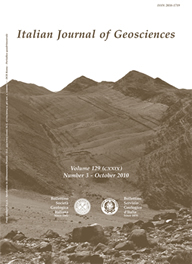
Tectonic evolution of the Northern Sicanian-Southern Palermo Mountains range in Western Sicily: insight on the exhumation of the thrust involved foreland domains
Giovanni Barreca(*), Francesco Emanuele Maesano(*) & Serafina Carbone(*)
(*) Dipartimento di Scienze Geologiche, Università degli Studi di Catania, Corso Italia, 57 - 95129 Catania. Corresponding author: Giovanni Barreca, e-mail: g.barreca@unict.it, Tel: +39095.7195739,
Fax: +39095.7195712. Francesco Emanuele Maesano e-mail: framae80@gmail.com Serafina Carbone e-mail: carbone@unict.it
Volume: 129 (2010) f.3
Pages: 429-440
Abstract
Geological mapping and structural analysis, coupled with extensive samplings on terrigenous Tertiary covers, enable us to reconstruct the structural setting as well as the tectonic evolution of the northern Sicanian-southern Palermo Mountains range in western Sicily. The analyzed region is a segment of the Apenninic-Maghrebian Orogen characterized by the occurrence of two regional superimposed tectonic edifices; the Apenninic-Maghrebian Chain (AMC) and the Pelagian Sicilian Thrust Belt (PSTB) which constitute the uppermost and lowermost structural level respectively.
The different structural associations generally suggest a multiphase tectonic history in which we distinguished three main deformational events.
The oldest one is characterized by the development of low-angle foreland-verging large thrust contacts. These usually propagated along Lower-Middle Miocene terrigenous levels and leads to the staking of the AMC. As a whole the AMC structured during Middle Miocene and tectonically overrode the Pelagian foreland since Tortonian time.
The subsequent tectonic phase developed as effect of continental collision with the propagation of south verging high-angle thrust faults. These involve mainly the underlying Pelagian foreland giving rise to the imbrications at depth of the PSTB.
The more recent tectonic phase starts since Middle Pliocene with the activation of NW-SE oriented right-lateral traspressive shear zones and associated double verging E-W striking thrust contacts.
These latter occurred mainly in the overlapping area between major shear zones and are responsible for the final uplift of the previously imbricate PSTB. During this tectonic stage the previously E-W oriented structural features suffered local clockwise rotations in the neighbours of the main right-lateral shear zones.
In this newly proposed structural framework, we interpreted the Mt. Kumeta and Rocca Busambra carbonate ridges as a Pliocene push-up type antiformal structures grown and exhumed at restraining stepovers in a contest of regional strike-slip kinematics.
Keywords
Get Full Text Attached